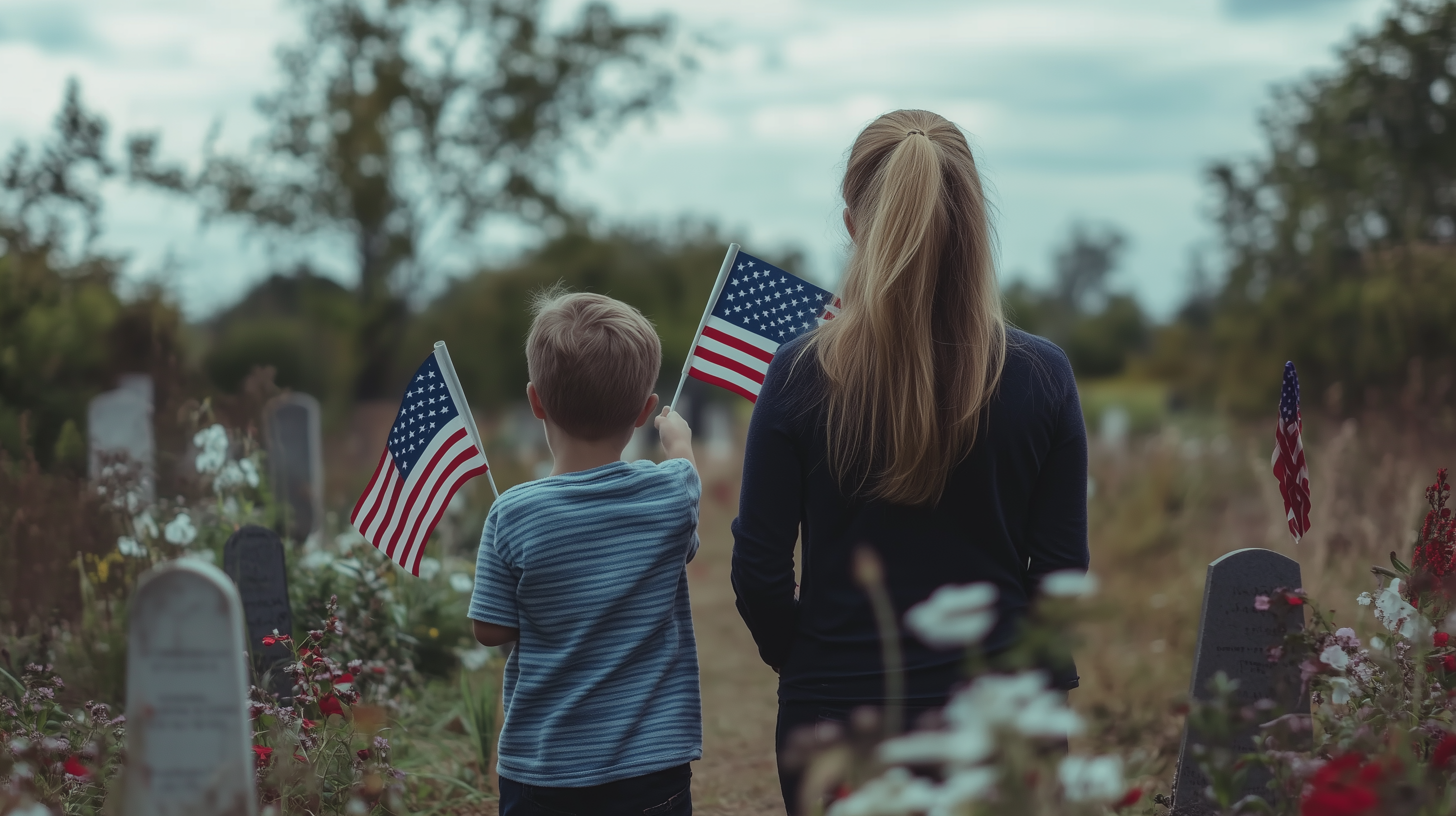Veterans of the armed forces may have a service-connected disability rating from the United States Department of Veterans Affairs (VA). Disabilities can make it challenging to find employment that allows veterans to live independently and provide for themselves and their families. The VA offers a program known as the Veteran Readiness and Employment Program (VR&E) that focuses on ways to help former service members reach their employment goals.
5 VR&E Support and Services Tracks
- Reemployment Track
- Rapid Access to Employment Track
- Self-Employment Track
- Employment Through Long-Term Services Track
- Independent Living Track
The VR&E offers vocational rehabilitation services to veterans. The program is part of a VA benefit that aids veterans who have at least a 10% disability rating from the VA. The VA’s mission to assist veterans in all aspects of their lives has led to the vocational rehabilitation program helping veterans return to work in jobs they love, start a business, or begin a new career.
Each service member in the program may be eligible for one of the different voc rehab tracks the VA offers, including the self-employment track and the independent living track. Veterans who receive education benefits in the form of tuition assistance from the Post-9/11 GI Bill can still qualify for VR&E services.
What Is the Veteran Readiness and Employment Program?
The VR&E program was formerly known as Vocational Rehabilitation and Employment and is also referred to as Chapter 31 benefits. This program provides veterans with vocational rehabilitation services. In the program, vocational rehabilitation refers to the process of providing resources and training tools to disabled veterans who might have challenges finding decent and lasting employment.
The program also assists former active duty service members with the training or education needed to advance or switch careers. Although the program is mostly geared toward voc rehab for veterans, an active duty service member may also receive rehabilitation services if they qualify.
Some of the services that veterans or active duty service members can receive include:
- Independent living services, including guidance on adaptive housing and living grants
- Understanding employer incentives related to VR&E
- Job training and resume development
- Skills and interests evaluations
- Apprenticeships and on-the-job training
- Educational counseling and training
- Career counseling services
- Business counseling services
Veterans participating in the VA vocational rehabilitation program should be prepared to accept employment services and counseling that assist them in finding suitable employment. The end goal for the veteran, depending on their ability level, should be finding a job they enjoy, building a business they love, or learning new ways to live independently.
Veterans who are currently utilizing VA education benefits may still qualify for the VA vocational rehabilitation program. The VA may allow veterans to choose which benefits they’d like to use for their education or training based on which program may work better for their goals.
How To Qualify for Veteran Readiness and Employment
The VA vocational rehabilitation program accepts both veterans and current service members. However, the eligibility requirements differ for each of them.
To be an eligible veteran, you must have received an honorable discharge from the military, have a service-connected disability rating of at least 10%, and complete the application for the program. Veterans will only be eligible for VA vocational rehabilitation within 12 years from the date you separated from active duty military service or received your first disability rating. Although you don’t necessarily need to receive VA disability benefits, you must have a disability rating to qualify.
An active duty service member may qualify for the rehabilitation program if they have a pre-discharge disability rating of at least 20% or are a current participant in the Integrated Disability Evaluation System (IDES).
If you’ve received a dishonorable discharge, you may be able to apply for a discharge upgrade or a review of your discharge from the VA. However, dishonorable discharges that remain in place will not qualify a veteran for employment services or independent living services through VR&E.
5 VR&E Support and Services Tracks
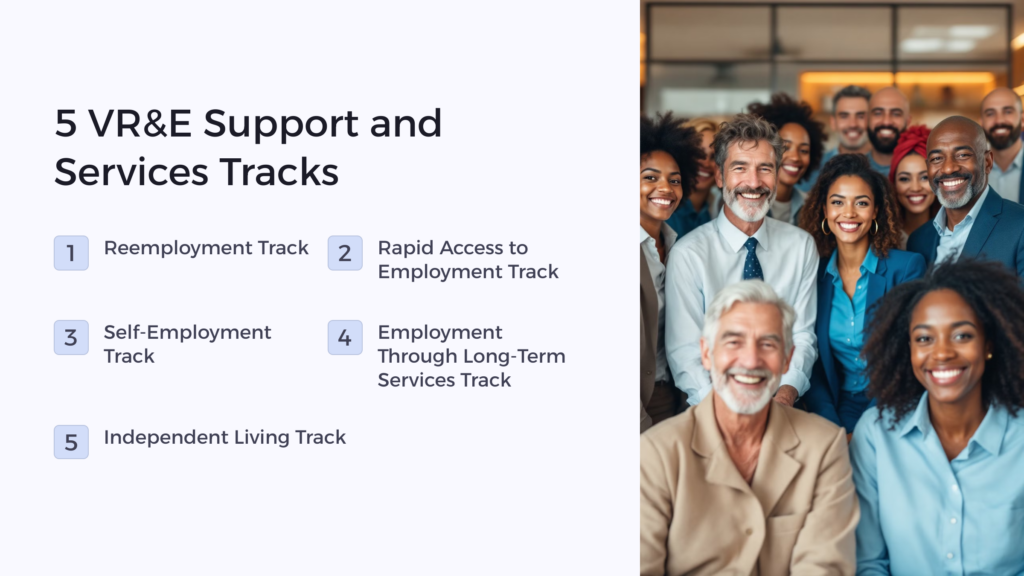
Veterans and service members who have passed the eligibility requirements for vocational rehabilitation services may complete one of five VA vocational rehabilitation tracks that focus on employment and independent living.
1. Reemployment Track
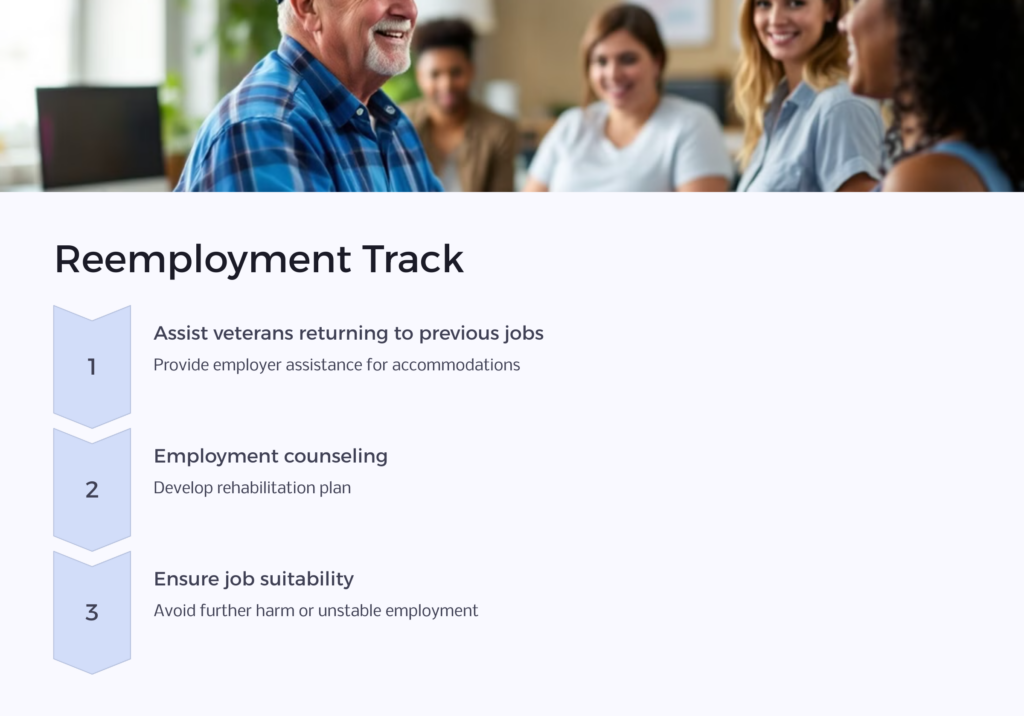
Many service members leave their current job to begin their military service. Upon leaving active military service with a disability, the veteran may find it difficult to return to their previous job if that job isn’t able to accommodate their needs. However, under the Uniformed Services Employment and Reemployment Rights Act (USERRA), veterans are protected from discrimination based on their disability or employment handicap.
The Reemployment track assists veterans in getting back to their former job by providing the employer with assistance in accommodating the veteran’s needs. The program may also provide the veteran with employment counseling and a rehabilitation plan to help them get back to work.
However, the VA will only support and assist a veteran in returning to their former job if that job is considered to be suitable for the veteran. In other words, it must not be a job that could further harm the veteran’s condition or is unstable employment.
2. Rapid Access to Employment Track
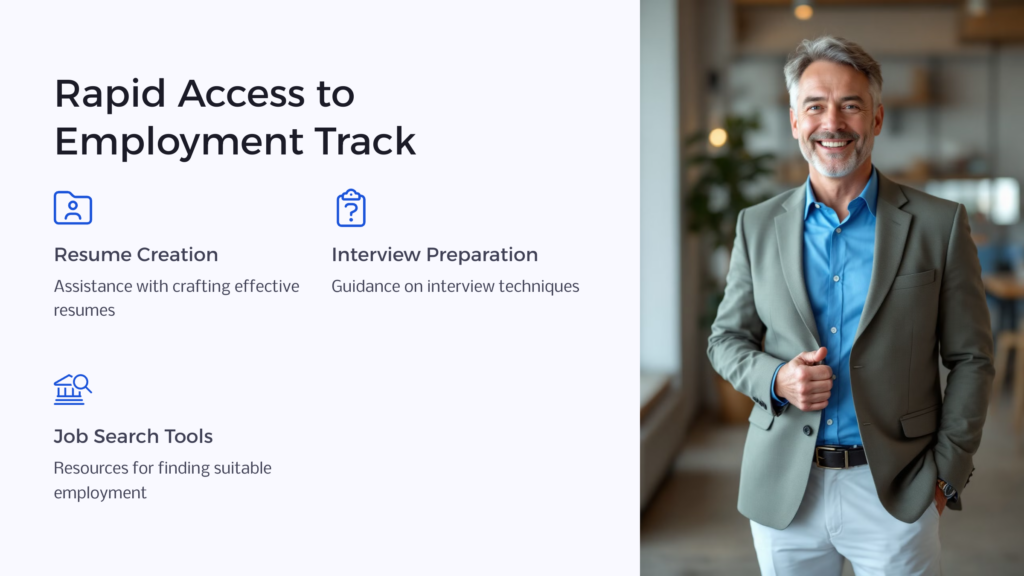
Veterans who have a specific skill set they’d like to apply to their future career path may seek VA vocational rehabilitation help through the Rapid Access to Employment track. This track focuses on job search tools that will make it easier for veterans to move into their ideal employment position after leaving active military service.
Some of the tools the Rapid Access to Employment track provides include career counseling, interview preparation, resume creation and editing, and assistance with job searches.
A veteran applying to this VA vocational rehabilitation track must already have experience, training, or education within their field of interest to qualify, as the program does not offer these resources. However, the track may provide some short-term certification training on an as-needed basis. A vocational rehabilitation counselor will also provide post-employment follow-up to ensure that the veteran has successfully transitioned into their new role.
3. Self-Employment Track

Veterans or service members who want to start a business and have a clear vision for a successful business may apply for the Self-Employment track. Veterans can work with a vocational educational counseling team with business backgrounds to develop a business plan, tweak their business concept into something that’s viable long-term, and find resources to get their business off the ground.
This track also provides some training involving how to operate a small business. Veterans can also get tuition assistance to obtain certifications and licensure necessary for their business, as well as financial assistance needed for business licenses or fees. Veterans may also qualify for financial assistance related to their business’s startup costs.
Once the veteran and their voc rehab counselor have developed and optimized a business plan, the VA will determine whether it’s a plan that could lead to a successful business before approving it for further assistance, like financial help or training.
4. Employment Through Long-Term Services Track
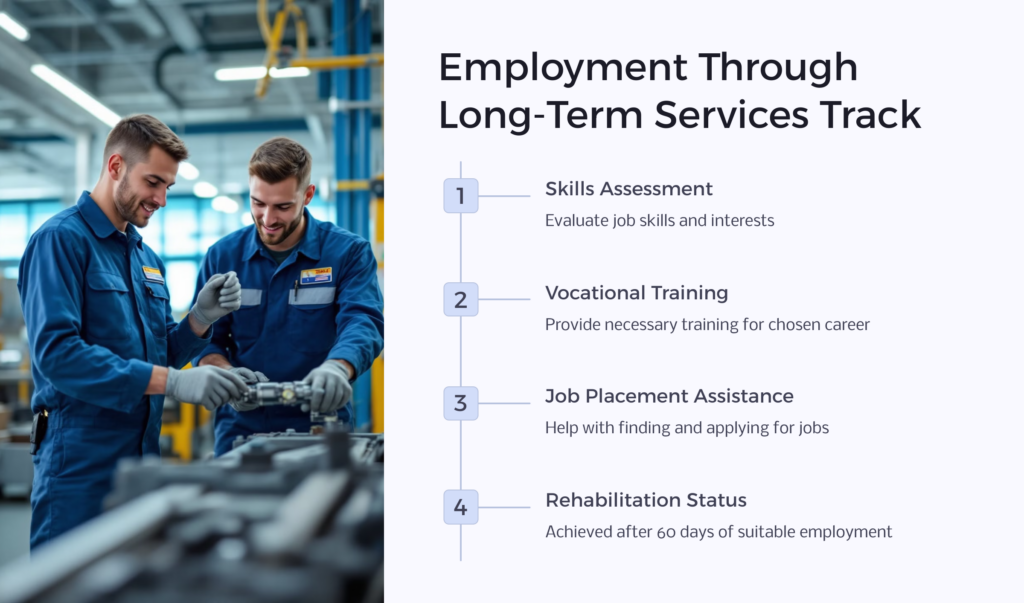
The Employment Through Long-Term Services track is best for veterans and service members who need extra assistance or training to succeed in their chosen career path. This track provides training to the veteran or servicemember to assist them in obtaining a job in their chosen career path or train them in a different, suitable career path.
The primary goal of this track is to help the veteran find a job that they can continue long-term. Together, the VR&E program and the veteran will work to develop an employment plan. The veteran will move to rehabilitated status when they’ve maintained a suitable employment position for at least 60 days upon review.
Some of the services a veteran can receive from the Employment Through Long-Term Services track include job skills assessment, on-the-job training, vocational training, and assistance with applying for and locating jobs. A vocational rehabilitation counselor may also provide resume coaching and career guidance.
5. Independent Living Track
The VR&E Independent Living track helps veterans get the care and resources they need to complete daily independent living tasks, such as dressing and socializing, when they can’t work due to a disability. The services may remain in place until the veteran is physically or mentally able to return to work and finds a suitable job, or up to 24 months, whichever is sooner. Some veterans may continue to use these services beyond 24 months.
Unlike other VA vocational rehabilitation tracks, the Independent Living track requires veterans to have a severe employment handicap that prevents them from working. The VR&E program will assist the veteran not only with vocational counseling and job-seeking tasks but will also help eligible veterans receive adaptive housing grants that assist in modifying their homes to fit their needs.
A veteran will be considered rehabilitated with the help of the program when he or she has significantly increased their level of independence and maintained that successful level of independence for at least 60 days.
How Do I Apply for VR&E Benefits?
To apply for the Veteran Readiness and Employment program, you’ll first need to receive a disability rating from the VA. To do so, you’ll need to apply for a VA disability claim through your VA regional office or online. Your veterans service officer can assist you with the process. You can also opt to fill out VA Form 28-0588 if you do not yet have a rating.
If you already have a disability rating, sign in to your eBenefits account to begin the application. This account lets you manage your veterans benefits online securely. Click the Apply link, followed by Veteran Readiness and Employment Benefits. Then, click Apply for Chapter 31.
Alternatively, you can apply by mail by filling out VA Form 28-1900 and mailing it to your VA regional office. You can also apply in person by filling out this form and bringing it to your closest VA office.
Understanding VA Vocational Rehabilitation Services
As a veteran or service member who needs assistance getting back into the workforce after leaving the service, you may qualify for VA vocational rehabilitation services. The VR&E program offers five tracks for various employment situations, including assistance for those who’d like to start their own business and aid for those with independent living needs.
VR&E provides vocational counseling, job-readiness evaluations, and help with job searches to get veterans employed. Depending on the track you choose, you might also qualify for adaptive housing assistance and financial assistance for business licensure.
Veterans or service members who were severely injured in a service-connected injury may be entitled to VR&E benefits without receiving a disability rating. However, those without a severe disability should have a disability rating on file to apply to streamline the application process. Speak with your veterans service officer if you need assistance with your application.
 Benefits.com Advisors
Benefits.com Advisors
With expertise spanning local, state, and federal benefit programs, our team is dedicated to guiding individuals towards the perfect program tailored to their unique circumstances.
Rise to the top with Peak Benefits!
Join our Peak Benefits Newsletter for the latest news, resources, and offers on all things government benefits.

















